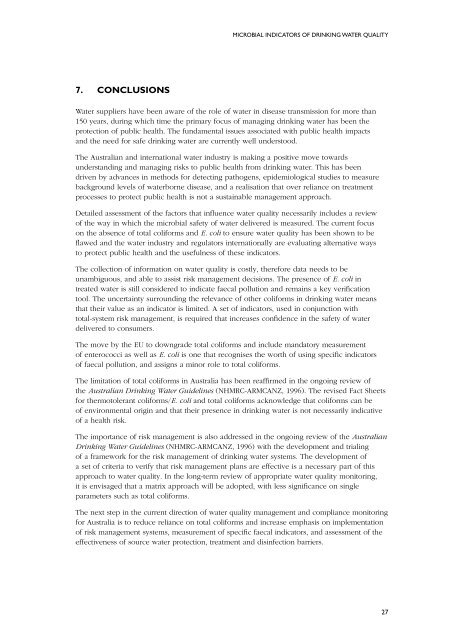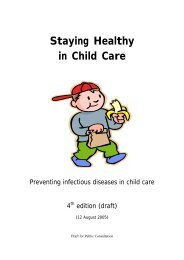Review of Coliforms - National Health and Medical Research Council
Review of Coliforms - National Health and Medical Research Council
Review of Coliforms - National Health and Medical Research Council
Create successful ePaper yourself
Turn your PDF publications into a flip-book with our unique Google optimized e-Paper software.
7. CONCLUSIONS<br />
MICROBIAL INDICATORS OF DRINKING WATER QUALITY<br />
Water suppliers have been aware <strong>of</strong> the role <strong>of</strong> water in disease transmission for more than<br />
150 years, during which time the primary focus <strong>of</strong> managing drinking water has been the<br />
protection <strong>of</strong> public health. The fundamental issues associated with public health impacts<br />
<strong>and</strong> the need for safe drinking water are currently well understood.<br />
The Australian <strong>and</strong> international water industry is making a positive move towards<br />
underst<strong>and</strong>ing <strong>and</strong> managing risks to public health from drinking water. This has been<br />
driven by advances in methods for detecting pathogens, epidemiological studies to measure<br />
background levels <strong>of</strong> waterborne disease, <strong>and</strong> a realisation that over reliance on treatment<br />
processes to protect public health is not a sustainable management approach.<br />
Detailed assessment <strong>of</strong> the factors that influence water quality necessarily includes a review<br />
<strong>of</strong> the way in which the microbial safety <strong>of</strong> water delivered is measured. The current focus<br />
on the absence <strong>of</strong> total coliforms <strong>and</strong> E. coli to ensure water quality has been shown to be<br />
flawed <strong>and</strong> the water industry <strong>and</strong> regulators internationally are evaluating alternative ways<br />
to protect public health <strong>and</strong> the usefulness <strong>of</strong> these indicators.<br />
The collection <strong>of</strong> information on water quality is costly, therefore data needs to be<br />
unambiguous, <strong>and</strong> able to assist risk management decisions. The presence <strong>of</strong> E. coli in<br />
treated water is still considered to indicate faecal pollution <strong>and</strong> remains a key verification<br />
tool. The uncertainty surrounding the relevance <strong>of</strong> other coliforms in drinking water means<br />
that their value as an indicator is limited. A set <strong>of</strong> indicators, used in conjunction with<br />
total-system risk management, is required that increases confidence in the safety <strong>of</strong> water<br />
delivered to consumers.<br />
The move by the EU to downgrade total coliforms <strong>and</strong> include m<strong>and</strong>atory measurement<br />
<strong>of</strong> enterococci as well as E. coli is one that recognises the worth <strong>of</strong> using specific indicators<br />
<strong>of</strong> faecal pollution, <strong>and</strong> assigns a minor role to total coliforms.<br />
The limitation <strong>of</strong> total coliforms in Australia has been reaffirmed in the ongoing review <strong>of</strong><br />
the Australian Drinking Water Guidelines (NHMRC-ARMCANZ, 1996). The revised Fact Sheets<br />
for thermotolerant coliforms/E. coli <strong>and</strong> total coliforms acknowledge that coliforms can be<br />
<strong>of</strong> environmental origin <strong>and</strong> that their presence in drinking water is not necessarily indicative<br />
<strong>of</strong> a health risk.<br />
The importance <strong>of</strong> risk management is also addressed in the ongoing review <strong>of</strong> the Australian<br />
Drinking Water Guidelines (NHMRC-ARMCANZ, 1996) with the development <strong>and</strong> trialing<br />
<strong>of</strong> a framework for the risk management <strong>of</strong> drinking water systems. The development <strong>of</strong><br />
a set <strong>of</strong> criteria to verify that risk management plans are effective is a necessary part <strong>of</strong> this<br />
approach to water quality. In the long-term review <strong>of</strong> appropriate water quality monitoring,<br />
it is envisaged that a matrix approach will be adopted, with less significance on single<br />
parameters such as total coliforms.<br />
The next step in the current direction <strong>of</strong> water quality management <strong>and</strong> compliance monitoring<br />
for Australia is to reduce reliance on total coliforms <strong>and</strong> increase emphasis on implementation<br />
<strong>of</strong> risk management systems, measurement <strong>of</strong> specific faecal indicators, <strong>and</strong> assessment <strong>of</strong> the<br />
effectiveness <strong>of</strong> source water protection, treatment <strong>and</strong> disinfection barriers.<br />
27

















